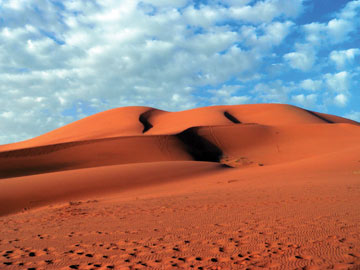|
NEWS NOTES
Dunes: they’re electric
 Chin-Kiu Chris Cheng |
Winds whipping across Earth’s deserts have the power to dramatically alter the landscape. Sand gets violently thrown about and, given time, even a desert’s dunes migrate. But the winds aren’t acting alone. Scientists think electricity plays a role as well.
In the desert, gusts of wind set tiny grains of sand in motion. Some are lofted into the air and begin to bounce across the surface of the dunes. The process is called saltation, a word that comes from saltus, the Latin word for “leap.” According to the rules of physics, these particles should jump higher as wind speeds increase. But they don’t. Even in the strongest winds, most of the particles never get more than a few centimeters off the ground.
Now, new research shows that electric fields may be holding the grains back. Nilton Renno, an associate professor of atmospheric and space sciences at the University of Michigan in Ann Arbor, and doctoral student Jasper Kok speculate that all the wind-driven bouncing causes the particles to pick up electrons from the surface, giving them a negative charge while leaving the dune’s surface positively charged. The result is a strong attraction between the two. As the winds intensify, increased rubbing generates even stronger electric fields, which should keep the particles from reaching greater heights. To test their hypothesis, Renno and Kok revised a classic model of saltation to include electric fields. The numbers generated by the new model, which appeared Jan. 11 in Physical Review Letters, matched real-life observations.
The authors suggest that better understanding of saltation could lead to better understanding of the processes underlying climate change. When saltating grains of sand strike the ground, “they eject small particles into the air,” Renno says. These airborne particles, called aerosols, probably have a cooling effect on climate and, Renno says, are one of the greatest sources of uncertainty in current climate change models. The new model could give researchers a better understanding of how the particles are released.

 Subscribe
Subscribe


